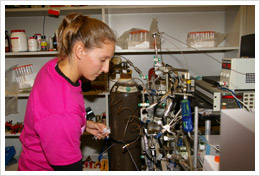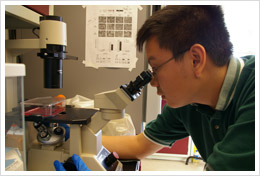(November 4, 2008)
Contact: Rick DelaHaya, Centenary News Services, 318.869.5073
Students Perfect Molecule Detection; Research to be Published

Julia Cornelius, a senior biophysics major, prepares samples for testing the detection of nitric oxide. Nitric Oxide plays a vital role in blood pressure maintenance, disease immunity, and memory formation.
audio courtesy of KEEL 710AM
SHREVEPORT, La.—After nearly four years of countless hours of research and hard work, a group of students at Centenary College has perfected a better method for detecting the important biological molecule, nitric oxide. Because of their persistence and dedication, their work has just been accepted for publication in the Journal of Biological Chemistry and will appear in print in early 2009.
The research project, Isotope Tracing Enhancement of Chemiluminescence Assays for Nitric Oxide Research, was aimed at finding new ways to detect and trace the molecule in biological samples. This molecule plays a vital role in blood pressure maintenance, disease immunity, and memory formation. The new method developed by Centenary students should help the development of drugs or dietary supplements that offset nitric oxide deficiency.
"The new method certainly represents an important development for areas of biology medicine related to nitric oxide," said Dr. Juan Rodriguez, a Professor of Physics and Biophysics at Centenary College who oversaw the project. "What is even more remarkable is that the method was entirely developed by undergraduate students."
The idea for the project grew out of collaboration between Rodriguez and Dr. Martin Feelisch, then a Professor of Medicine and Biochemistry at Boston University. Feelisch is known internationally for developing a chemical process that releases nitric oxide from biological samples, allowing it to be detected with a conventional nitric oxide detector. The two were looking for a different type of detector that could also differentiate between isotopes of nitric oxide, the naturally abundant one and an artificial heavier form. The idea was that if one were to administer drugs or supplements containing the heavier form, then the detector could determine how much of the body's nitric oxide came from what was administered compared to what was made by the body.
They decided to try to use a mass spectrometer detector, which had never been tried in conjunction with the type of chemical process that Feelisch and others had developed.
"At this point we thought it was a great research project for the students at Centenary to become involved with," said Rodriguez. "There was no guarantee it would work well enough to be of use, but it would at least be a valuable educational experience for our undergraduate students." Rodriguez was immediately surprised at how receptive students were to the project. "They understood immediately the relevance of the project, persevered through many of its frustrating moments, and even though most were not able to see the project to its conclusion they made sure the next generation of students were trained to follow in their steps. They drove this project, while I basically acted as a mentor and advisor. I am very proud of what they have accomplished."

Tuan Tran, a junior biology major, examines cells he raised for the nitric oxide research project. The project was aimed at finding methods for detecting the molecule, nitric oxide in biological samples.
Photos by Rick DelaHaya, Centenary News Service
Having an interest in research, Julia Cornelius, a biophysics major, approached Rodriguez earlier this summer about the project. According to the Weatherford, Texas native, she wanted to gain some insight and knowledge about what research was all about, and if it was something that she would be interested in pursuing after graduation.
"This has been an amazing experience for me," said Cornelius. "I have been able to really see what the research process is all about, and how we as students were able to conduct all the research with input from our mentor, Dr. Rodriguez. I am so much more prepared now to continue my education when I attend medical school after I graduate."
Echoing her sentiments, Tuan Tran, a junior from Mansfield, La., jumped into the project because the thought of research was only an abstract idea. As a biology major, he also started work on the project in May and wanted to try his hand at research and see if he could apply it to the real world.
"I had read about the research and how important it was and its implications," said Tran. "It has been interesting to apply what I learned in cell biology to raising cells for the project. I could not have had this opportunity or the interaction with my professor at a larger school."
The project has attracted seven students over the past four years, and funding from the Louisiana Biomedical Research Network and the National Science Foundation. "These grants were used to support the students and to buy new equipment and supplies," added Rodriguez.
The students will make a presentation on the project at the Society for Free Radicals in Biology and Medicine, November 21, in Indianapolis.
Students involved in the research included:
- Julia Cornelius, senior, Biophysics major
- Tuan Tran, junior, Biology major
- Nicole Turner, Biophysics major
- Abigail Piazza '08, Neuroscience major
- Lauren Mills '07, Biology major
- Ryan Slack '06, Biophysics major
- Sean Hauser '05, Biology major
About Centenary College of Louisiana
Centenary College is a private, four-year arts and sciences college affiliated with the United Methodist Church. Founded in 1825, it is the oldest chartered liberal arts college west of the Mississippi River and is accredited by the Southern Association of Colleges and Schools. Centenary is one of 16 colleges and universities constituting the Associated Colleges of the South and is regularly rated as one of the top colleges in the South. In 2008 Centenary College celebrates 100 years in Shreveport and Bossier City.
